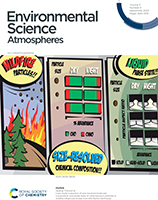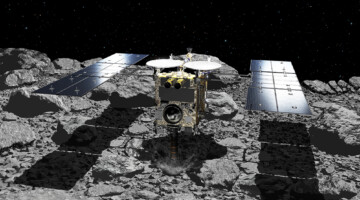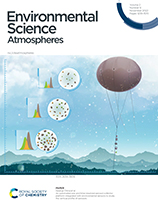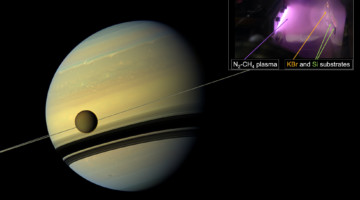Researchers controlled the mixing of electron-donating and -accepting constituents of an organic photovoltaic (OPV) material made using a process that replaces toxic solvents with water. With efficiencies comparable to less eco-friendly OPVs, this material shows promise for many advanced device and building applications. Read more »![]()
![]()
Case study evaluation of size-resolved molecular composition and phase state of carbonaceous particles in wildfire influenced smoke from the Pacific Northwest
Wildfires are significant sources of carbonaceous particles in the atmosphere. Given the dependence of atmospheric processes on particle physical and molecular properties, the interplay between particle size, phase state and chemical composition is investigated here for aerosols influenced by a 2021 Pacific Northwest wildfire event. Read more »
Toward High Efficiency Water Processed Organic Photovoltaics: Controlling the Nanoparticle Morphology with Surface Energies
Researchers achieve power conversion efficiencies approaching 10% by careful control of the nanoparticle and thin film morphologies thanks to surface energy considerations. This approach opens the route to low environmental footprint photovoltaics. Representing the promise of this sustainable direction in organic photovoltaics, the image shows the deposition of the active layer from water-based nanoparticles inks. Read more »
Vestiges of the Early Solar System in Ryugu Asteroid
Samples returned to Earth from the asteroid Ryugu revealed that the building blocks of life formed 4.6 billion years ago in the extreme cold of space, followed by reaction with water. The dark, coal-like organic matter in the carbonaceous asteroid could have contributed to the formation of habitable planetary environments. Read more »![]()
![]()
Increasing the Energy Density of Hybrid Supercapacitor Electrodes
Hybrid supercapacitors (HSCs) integrate the merits of batteries with those of supercapacitors. However, the fraction of active material in HSC electrodes has remained too low for commercial requirements. Now, researchers have found a clever way to increase the active-mass ratio to achieve dramatic improvements in key measures. Read more »
Vertical Gradient of Size-Resolved Aerosol Compositions over the Arctic Reveals Cloud Processed Aerosol in-Cloud and above Cloud
Vertical distribution of size-resolved chemical composition of Arctic aerosol particles was investigated in different cloud layers. Multimodal microspectroscopy analysis reveals a broadening of chemically-specific size distribution above the cloud top. Read more »
Sub-4 nm mapping of donor–acceptor organic semiconductor nanoparticle composition
We report, for the first time, sub-4 nm mapping of donor : acceptor nanoparticle composition in eco-friendly colloidal dispersions for organic electronics. This technology shows great promise for the optimization of organic semiconductor blends for organic electronics and photocatalysis and has further applications in organic core–shell nanomedicines. Read more »
Macromolecular organic matter in samples of the asteroid (162173) Ryugu
We investigated the macromolecular organic matter in samples of the asteroid Ryugu—brought to Earth by the Hayabusa2 spacecraft—measuring its elemental, isotopic, and functional group compositions along with its small-scale structures and morphologies. Analytical methods used included spectro-microscopies, electron microscopy, and isotopic microscopy. Read more »
An automated size and time-resolved aerosol collector platform integrated with environmental sensors to study the vertical profile of aerosols
Researchers present the vertical distribution of size-resolved aerosol composition over an agricultural site by deploying a newly developed lightweight automated size- and time-resolved aerosol collector (STAC) platform integrated with environmental sensors on unmanned aerial systems (e.g., tethered balloon systems). Read more »
New Insight into Titan’s Hazy Atmospheric Chemistry
Researchers simulated the complex chemistry that may be occurring in the hazy atmosphere of Saturn’s largest moon, Titan, and analyzed the reaction products at the ALS. The work provided new insights into what future Titan probes may encounter upon arrival and what the atmosphere of Earth may have been like eons ago. Read more »









